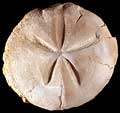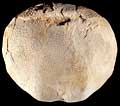The Echinoid Directory
Gregoryaster Lambert, 1907, p. 59
| Diagnostic Features |
|
|---|---|
| Distribution | Upper Cretaceous (Maastrichtian), India; ?Eocene, Spain; Miocene, circum Mediterranean. |
| Name gender | masculine |
| Type | Pericosmus coranguinum Gregory, 1892, p. 615, by original designation. |
| Species Included | Although Lambert & Thiery (1921) included many species from Upper Cretaceous to Miocene in age in this taxon, they did not realise the type species has traces of a posterior marginal fasciole. Consequently, few of species they list can be included for certain at present.
|
| Classification and/or Status | |
| Remarks | Differs from Hemiaster in having long, narrow subequal petals in well defined grooves and in having the peripetalous fasciole indented behind the anterior petals by two plates and crossing the anterior interambulacra on plate 4. The lateroanal part of the marginal fasciole is variably developed, but traces can be seen in the holotype. It differs from Faorina in having no second branch to the peripetalous fasciole anteriorly, in having four rather than three gonopores, and amphiplacous plating adorally. Opissaster is basically similar but has no trace of the marginal fasciole and has much shorter posterior petals than anterior petals. |



